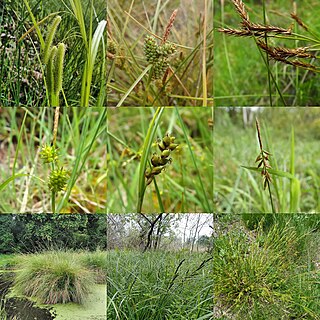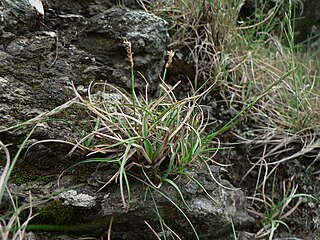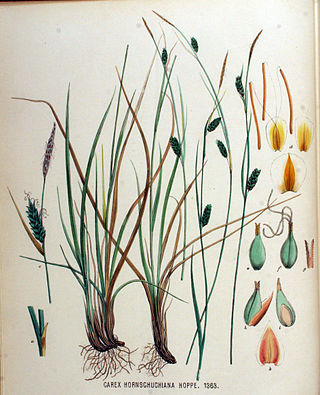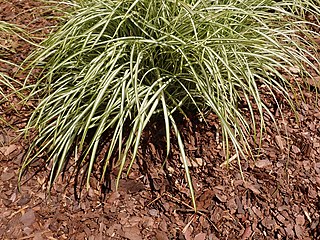
Ornamental grasses are grasses grown as ornamental plants. Ornamental grasses are popular in many colder hardiness zones for their resilience to cold temperatures and aesthetic value throughout fall and winter seasons.

Carex is a vast genus of over 2,000 species of grass-like plants in the family Cyperaceae, commonly known as sedges. Other members of the family Cyperaceae are also called sedges, however those of genus Carex may be called true sedges, and it is the most species-rich genus in the family. The study of Carex is known as caricology.

Carex morrowii, the kan suge, Morrow's sedge, Japanese grass sedge or Japanese sedge, is a species of flowering plant in the family Cyperaceae. It is native to central and southern Japan, and has been introduced to Belgium, Denmark and Austria.

Populus × canadensis, known as Canadian poplar or Carolina poplar, is a naturally occurring hybrid of Populus nigra and Populus deltoides. It is a vigorous, broadly columnar, deciduous tree growing to 40 m (130 ft), which is commonly used by landscape architects. Cultivars include 'Robusta' and 'Aurea', which has won the Royal Horticultural Society's Award of Garden Merit.

Carex viridula, known as little green sedge, green sedge, or greenish sedge, is a small flowering plant native to North America, Europe, Asia, and Morocco.

Carex rupestris, called the curly sedge and rock sedge, is a species of flowering plant in the family Cyperaceae, native to temperate and subarctic North America, Greenland, Iceland, Europe, and Asia.

Carex hostiana, the tawny sedge, is a species of flowering plant in the genus Carex, native to Europe and northeast Canada, and extinct in Massachusetts. It is a member of the Carex flava species complex.

Carex ornithopoda, called the bird's foot sedge, is a species of flowering plant in the genus Carex, native to most of Europe, and Anatolia. A variegated cultivar is commercially available.

Carex elongata, the elongated sedge, is a species of flowering plant in the family Cyperaceae, native to Europe, the Caucasus, western Siberia, Kazakhstan, and the Altai. It occurs in boggy woodland and wet meadows, where it forms dense tussocks up to about 1 m tall.

Potentilla aurea, the golden cinquefoil, is a species of flowering plant in the family Rosaceae. It is native to the mountains of mainland Europe, and has been introduced to Turkey. A number of cultivars are available, including 'Aurantiaca', 'Goldklumpen', and 'Plena'.

Carex flagellifera, the weeping brown sedge or Glen Murray tussock sedge, is a species of flowering plant in the family Cyperaceae. It is native to Tasmania, New Zealand, and the Chatham Islands, and it has been introduced to the Kermadec Islands and Great Britain. There are a number of cultivars, including 'Auburn Cascade', 'Coca-Cola', 'Frosted Curls', 'Kiwi', 'Rapunzel', and 'Toffee Twist'.
Carex chathamica is a species of sedge in the family Cyperaceae, native to the Chatham Islands of New Zealand. Grey-backed storm petrels nest in its tufts.

Carex gaudichaudiana, also known as fen sedge, is a tussock-forming species of perennial sedge in the family Cyperaceae. It is native to parts of Australia and New Zealand.
Carex catharinensis is a tussock-forming species of perennial sedge in the family Cyperaceae. It is native to parts of eastern parts of South America.
Carex krauseorum, commonly known as Krause's sedge, is a tussock-forming species of perennial sedge in the family Cyperaceae. It is native to subarctic areas of Greenland, Alaska, northern Canada and Russia.

Carex michauxiana, also known as Michaux's sedge, carex de Michaux or yellowish sedge in Canada, is a tussock-forming species of perennial sedge in the family Cyperaceae. It is native to eastern parts of North America and parts of Asia.
Carex alsophila, commonly known as forest sedge, is a tussock-forming species of perennial sedge in the family Cyperaceae. It is native to Victoria in south eastern Australia.
Carex cephalotes, also known as wire-head sedge, is a tussock-forming species of perennial sedge in the family Cyperaceae. It is native to south eastern Australia and New Zealand.

Oenothera stricta, the fragrant evening primrose, is a species of flowering plant in the family Onagraceae. It is native to the Desventurados Islands, Chile, and southern Argentina, and it has been introduced to many locations around the world. The unimproved species is available from commercial suppliers, as is a cultivar, 'Sulphurea'. The Royal Horticultural Society considers both to be good plants to attract pollinators.















